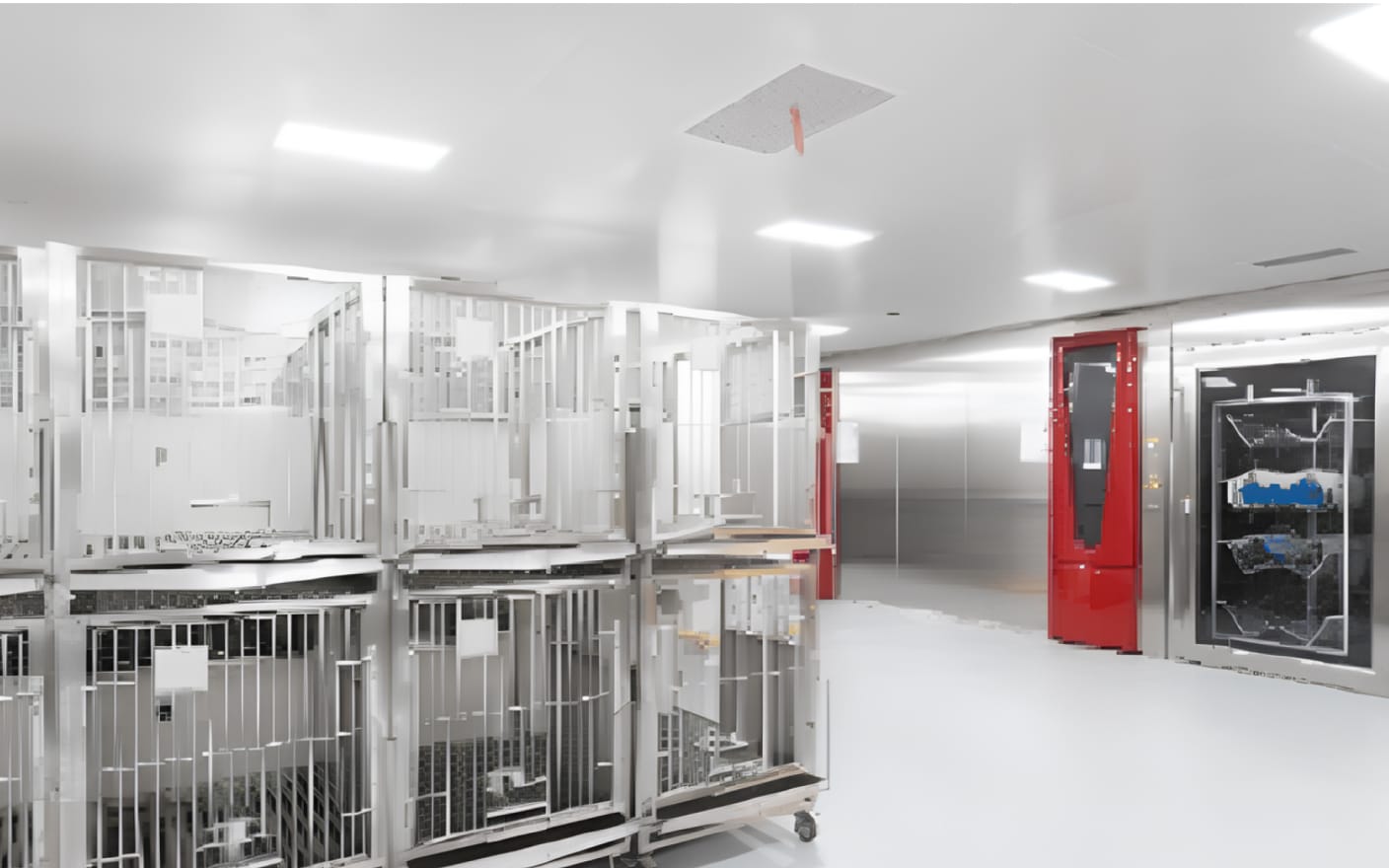Oral administration is the most common dosing method in clinical settings due to its good compliance, cost-effectiveness, safety, and various dosage forms [1]. For orally administered drugs, absorption and bioavailability are the primary focuses of researchers. Solubility and permeability are the two main factors that influence drug bioavailability. Evaluating the permeability of lead compounds in the early stages of drug development can accelerate the research process and reduce costs [2]. Quantitative analysis of drug intestinal absorption helps study the oral bioavailability of drugs [3]. This article aims to introduce the methods for studying the in vivo and in vitro permeability of oral drugs and the application strategies at different stages of research and development.
In vivo intestinal absorption research methods
Oral bioavailability (F) is a product of fraction absorbed (Fa), fraction escaping gut-wall elimination (Fg), and fraction escaping hepatic elimination (Fh). (shown in Figure 1). Currently, methods to quantify intestinal absorption parameters mainly include obtaining the oral bioavailability (F) and the fraction of the drug that enters the portal vein after oral absorption (Fa × Fg), as well as measuring the effective permeability coefficient (Peff) through in situ single-pass intestinal perfusion (SPIP). By studying various intestinal absorption parameters, especially Fa × Fg, researchers can more accurately describe the oral absorption process of drugs.

Figure 1. Simulation of the oral bioavailability calculation process [4]
In vivo methods to obtain Fa × Fg Values
Studies have shown that Fa × Fg is more suitable than F for evaluating the intestinal absorption of compounds, as it clearly indicates whether low oral bioavailability is caused by low intestinal permeability or high hepatic metabolism, facilitating the optimization of bioavailability in later stages (Table 1). In general, a good absorption profile is characterized by F ≥ 20% and hepatic clearance (Qh) < 25% of the compound, which corresponds to a minimum Fa × Fg value of approximately 0.26, and can be used to preliminarily assess compound intestinal absorption [5]. Fa × Fg can be obtained through a variety of in vivo experiments, and the appropriate research methods can be selected based on different experimental needs and metabolic characteristics of compounds, which can more effectively evaluate the intestinal absorption of drugs, as shown in Table 2.
|
Property |
Compound A |
Compound B |
|
Cl(% Qh) |
90 |
10 |
|
F(%) |
5 |
5 |
|
Fa × Fg |
0.50 |
0.06 |
|
PK characteristic |
High clearance |
Low absorption |
Table 1. Potential differences in oral bioavailability and intestinal absorption [5]
|
Method |
Merit |
Shortcoming |
Formula |
|
Compare the AUC of PO and IP (HPV) |
Data are accurate in the presence of intestinal metabolism of the drug |
The drug has a weak first-pass hepatic effect |
|
|
Compare the AUC of PO and IV administration |
When F is known, hepatic utilization (Fh) can be calculated to determine the presence of an extrahepatic elimination pathway |
Drugs are eliminated only by the liver |
|
|
Mass Balance (Fick's Fick's law of diffusion ) |
Obtain relevant data on an animal |
In the presence of systematic intestinal metabolism, Fa × Fg may be underestimated |
|
|
Clearance method |
Intestinal metabolized drugs are indicated |
Complex procedure, Drugs are eliminated only by the gut and/or liver |
|
Table 2. Different calculated experimental models of Fa × Fg [3]
Note: PO, Oral administration; IV, Intravenous administration; IP, Intraperitoneal administration; HPV, Hepatic Portal vein cannulation; AUCpo,0-∞, Area under the curve when the drug is in systemic plasma after oral administration; AUCip /hpv,0-∞, Area under the curve after intraperitoneal or portal vein administration; Dip /hpv, Dose for intraperitoneal or portal vein administration; Dpo, Dose for oral administration; Qh, Hepatic blood flow; Cls, Hepatic clearance rate; AUCiv, Area under the curve after intravenous administration; Qpv, Portal vein blood flow; AUCpo, sys, Area under the plasma concentration-time curve in systemic circulation; AUCpo, pv, Area under the plasma concentration-time curve in portal vein blood; Clb, Whole blood clearance rate.
Evaluating effective permeability coefficient Peff using in situ single-pass intestinal perfusion (SPIP) models
Among the FDA-approved methods for assessing permeability, rat intestinal perfusion studies have proven to be a reliable and physiologically relevant method for permeability measurement and BCS classification [6]. While transporter types and expression levels may vary by species, there is a high correlation (r² = 0.8 ⁓ 0.95) between the intestinal permeability of humans and rats for drugs that undergo carrier-mediated absorption and passive diffusion [7]. Additionally, the intestinal tissue has an unstirred water layer (UWL), which is a stagnant water barrier formed between the intestinal villi surface and water molecules, significantly affecting the permeability of lipophilic compounds [8]. The thickness of the UWL in rats is about 700 μm, which is similar to that in humans, making it advantageous for assessing the permeability of lipophilic compounds (as shown in Figure 2). The SPIP model, which maintains a complete blood supply and functional intestinal barrier, allows blood sampling at the mesenteric vein to better reflect the absorption or metabolism of drugs in the intestine. WuXi AppTec DMPK has developed the SPIP model, showing a good correlation with human Peff values.

Figure 2. The main influence factors of Peff

Figure 3. Diagram of rat SPIP in different intestinal segments [9]

Figure 4. Correlation of Peff values measured by SPIP in rats with human data
In vitro models for evaluating apparent permeability coefficient (Papp)
The determination of in vitro permeability can extend many research contents in the drug discovery stage, assist in predicting and interpreting in vivo pharmacokinetic results, and use it for the consistency evaluation of generic drugs. Currently, the recommended models for measuring the intestinal permeability of drugs in vitro include in vitro animal intestinal tissue models and monolayer artificially cultured epithelial cell models (Figure 5) [10-12]. The formula for calculating the apparent permeability coefficient (Papp) of the in vitro permeability model is as follows:

dC/dt: The concentration of a drug changes over time
v: The volume of the storage area
C0: The initial concentration of the supply zone
A: Tissue area

Figure 5. In vitro permeability model
Cell models
In vitro cell models include Caco-2, MDCK, and LLC-PK1, etc, among which Caco-2 cells are derived from human colon cancer cells and are widely used to study the bidirectional drug delivery and Caco-2 model is one of the most essential tools to elucidate the "druggability" of oral candidate compounds [13]. Caco-2 cells are cultured in a transwell chamber to form a single cell layer with tight junctions, and the apical side of this layer expresses various transporters, such as P-gp, BCRP, and PEPT1. Although the Caco-2 cell model lacks the mucus layer of the intestinal wall, lacks some metabolic enzymes, and has barrier properties that are similar to those of colonic epithelial cells but somewhat different from those of small intestinal epithelial cells [8]. In addition, it has been widely used in research because of its reliability, predictability, and high acceptance. WuXi AppTec DMPK has established a comprehensive in vitro permeability evaluation system (PAMPA, Caco-2, MDCK II, and MDR1-MDCK II).
Ex vivo intestinal tissue model
In vitro intestinal tissue models have been widely used to perform pharmacokinetic studies, such as drug absorption in different intestinal segments, drug metabolism or gastrointestinal prodrug conversion, efflux transport, multidrug resistance, drug interactions, and the effects of efflux transport regulators on drug absorption [14-15]. The rat intestine is commonly used in in vitro intestinal tissue models, and the advantage of using the rat intestine is that the drug obtains a permeability coefficient in the human intestine, which is similar to that in the rat intestine. There are no noticeable species differences[16] (Figure 6). Ex vivo experiments can be used to intercept different intestinal segments in rats and evaluate the absorption of drugs in different intestinal segments (Table 3).

Figure 6. High and low permeability drugs in rat and human intestines
|
Intestine |
Atenolol |
Metoprolol |
Ketoprofen |
Enalaprilat |
|
Jejunum |
11.5±4.09 a, b |
4.22±1.42 b |
20.0±13.4 a |
4.74±3.25 a, b |
|
Ileum |
7.81±4.76 c |
16.8±7.67 a, c |
24.6±8.38 a |
2.87±1.69 |
|
Colon |
12.2±3.88 a |
7.66±3.12 b |
17.9±10.6 a |
4.21±1.24 a |
Table 3. Determination of Papp for different drugs in various intestinal segments (×10-6 cm/s) [17]
Ex vivo intestinal models are widely used, including the Everted gut sac and the Ussing Chamber models. The experimental operation of the Everted gut sac model is relatively simple; the intact intestinal segment retains the mucus layer, and the intestinal sac is small, which is helpful for the determination of osmotic drug concentration. The Ussing Chamber model requires a small intestinal segment area, and removing the serous layer makes it relatively challenging to operate. The Ussing Chamber model has an electrophysiological monitoring system, which can monitor intestinal activity in real time and reduce the amount of animal use. However, the intestinal activity duration of these ex vivo models is limited [5].

Figure 7. WuXi AppTec DMPK Ussing Chamber model (left) and Everted gut sac model (right)
WuXi AppTec DMPK has successfully established the Ussing Chamber model and Everted gut sac model. As shown in Table 4, the permeability parameters obtained by the two models are basically the same as those in the literature, and it can be seen from Figures 8 and 9 that the slope of the curve represents the transmembrane rate of the drug, indicates that the Ussing Chamber model maintained longer intestinal activity.
|
Group |
Drugs |
Everted gut sac model Mean Papp (×10-6 cm/s) |
Ussing chamber Mean Papp (×10-6 cm/s) |
Literature Papp (×10-6 cm/s) |
|
BCS I |
Metoprolol |
2.69 ± 0.79 |
3.60 ± 1.53 |
- 3.39 ~ 16.8 |
|
BCS I /Ⅱ |
Ketoprofen |
14.9 ± 2.9 |
7.49± 2.57 |
8.2 ~ 24.6 |
|
BCS Ⅲ |
Atenolol |
0.51 ± 0.13 |
2.68 ± 0.60 |
- 1.7 ~ 11 |
|
BCS Ⅲ |
Digoxin |
0.66 ± 0.12 |
0.85 ± 0.32 |
0.68 ~ 3.4 |
|
BCS Ⅳ |
Candesartan |
0.41 ± 0.13 |
1.80 ± 0.32 |
1.16 |
Table 4. WuXi AppTec DMPK in-house data and reported value of Ussing chamber and Everted gut sac model [17-19]

Figure 8. Variation of drug permeation concentration over time in the Ussing Chamber model

Figure 9. Changes in drug permeation concentration over time in the Everted gut sac model
WuXi AppTec DMPK intestinal absorption research platform
WuXi AppTec DMPK has developed a robust platform for studying intestinal absorption, summarizing methods for in vivo, in vitro, and in situ research (shown in Figure 10). These methods can be used to evaluate drug intestinal permeability, conduct permeability ratings, and assess bioequivalence. In vivo methods can obtain parameters related to oral absorption, such as Fa × Fg × Fh, while in vitro and in situ methods can provide permeability parameters (Papp or Peff) to evaluate the permeability of drug to cross intestinal epithelial cells.

Figure 10. DMPK intestinal absorption research platform and parameters for oral drug evaluation
Strategies for studying the intestinal absorption characteristics of drugs
The oral drug development paradigm is evolving, with permeability becoming an increasingly important consideration for the successful development of oral candidates, especially for new chemical entities such as synthetic peptides and PROTACs (proteolysis targeting chimeras). This article summarizes the evaluation methods for intestinal absorption permeability data across different stages of drug discovery and development (shown in Figure 11). In the drug discovery phase, high-throughput methods are often used for rapid screening to facilitate the understanding of the molecular structure of compounds and adjust the molecular structure or direction of development. As R&D projects move into the drug development phase, approaches closer to physiological state are used to improve understanding of the mechanisms underlying compound permeability and clinical effects [5]. Different methods are used for collaborative evaluation at different stages to provide scientific and reliable reference data for clinical trials.

Figure 11. Permeability research from drug discovery to development [5]
Conclusion
WuXi AppTec DMPK has successfully established an in vivo and in vitro intestinal absorption research platform to keep pace with drug development strategies. Establishing an intestinal absorption research system through the existing model can quickly and efficiently determine the absorption characteristics of drugs, and continuously enrich the PK database of intestinal absorption compounds. Selecting the appropriate model to determine the permeability or in vivo absorption of unknown compounds provides accurate and efficient research services for early screening of oral drugs, thereby accelerating the drug development process.
Talk to a WuXi AppTec expert today to get the support you need to achieve your drug development goals.
Authors: Jieyu Xiao, Furong Jiao, Xuan Dong, Cheng Tang
Committed to accelerating drug discovery and development, we offer a full range of discovery screening, preclinical development, clinical drug metabolism, and pharmacokinetic (DMPK) platforms and services. With research facilities in the United States (New Jersey) and China (Shanghai, Suzhou, Nanjing, and Nantong), 1,000+ scientists, and over fifteen years of experience in Investigational New Drug (IND) application, our DMPK team at WuXi AppTec are serving 1,600+ global clients, and have successfully supported 1,500+ IND applications.
Reference
[1]Balimane P V, Chong S, Morrison R A. Current methodologies used for evaluation of intestinal permeability and absorption[J]. J Pharmacol Toxicol Methods. 2000, 44(1): 301-312.
[2] Zhang W, Meng F. Research Progress on Drug Permeability Prediction Methods[J]. Drug Evaluation Research, 2015, 38(4): 429-434.
[3] Quan N, Guo J. Kwon Nyeong-gil. Handbook for Industrial Scientists: Basic Pharmacokinetics, Pharmacodynamics and Drug Metabolism[M]. 2022: 30-46.
[4] Parodi A, Buzaeva P, Nigovora D, et al. Nanomedicine for increasing the oral bioavailability of cancer treatments[J]. J Nanobiotechnology. 2021, 19(1): 354.
[5] Yang W, Lipert M, Nofsinger R. Current screening, design, and delivery approaches to address low permeability of chemically synthesized modalities in drug discovery and early clinical development[J]. Drug Discov Today. 2023, 28(9): 103685.
[6] CDER/FDA, Guidance for industry waiver of in vivo bioavailability and bioequivalence studies for immediate-release solid oral dosage forms based on a biopharmaceutics classification system, Cent[J]. FDA. 2000.
[7] Lozoya-Agullo I, Gonzalez-Alvarez I, Zur M, et al. Closed-loop doluisio (colon,small intestine) and single-pass intestinal perfusion (colon, jejunum) in rat-biophysical model and predictions based on caco-2[J]. Pharm Res. 2017, 35(1): 2.
[8] Kiyohiko Kanno. Biopharmaceutical modeling and simulation: theory, practice, methods, and applications[M]. Xu Mingzhe, 2021, 58, 187, 247.
[9] SunW, Gao J, Fan R, et al. The effect of particle size on the absorption of cyclosporin a nanosuspensions[J]. Int J Nanomedicine. 2022, 17: 1741-1755.
[10] U.S. Food and drug Administration. Guidance for Industry: Waiver of in vivo bioavailability and bioequivalence studies for imeadiate-release solid oral dosage forms based on abiopharmaceutics classification system[R]. washington : FDA. 2015.
[11] European Medicines agency. Note for guidance on the investigation of bioavailability and bioequivalence [R]. CPMP/EWP/QWP/1401/98 Rev1,Appendix Ⅲ.Amsterdam: EMA, 2010.
[12] China food and durg administration. Guidelines for the exemption of human bioequivalence test [R]. Beijing: china medical science press, 2016.
[13] Panse N, Gerk PM. The Caco-2 Model: Modifications and enhancements to improve efficiency and predictive performance[J]. Int J Pharm. 2022, 25, 624: 122004.
[14] Machado R M, Palmeira-de-Oliveira A, Gaspar C, et al. Studies and methodologies on vaginal drug permeation[J]. Advanced Drug Delivery Reviews. 2015, 92: 14-26.
[15] Wilson TH, Wiseman G. The use of sacs of everted small intestine for the study of the transference of substances from the mucosal to the serosal surface[J]. J Physiol 1954; 123: 116–125
[16] Hans Lennernäs. Regional intestinal drug permeation: Biopharmaceutics and drug 5 development [J]. European Journal of Pharmaceutical Sciences, 2013.
[17] Roos C, Dahlgren D, Sjögren E, et al. Regional intestinal permeability in rats: a comparison of methods[J]. Mol Pharm. 2017, 14(12): 4252-4261.
[18] Hornberger K R, Araujo E M V. Physicochemical property determinants of oral absorption for PROTAC protein degraders[J]. J Med Chem. 2023, 66(12): 8281-8287.
[19] Guan C, Yang Y, Tian D, et al. Evaluation of an ussing chamber system equipped with rat intestinal tissues to predict intestinal absorption and metabolism in humans[J]. Eur J Drug Metab Pharmacokinet. 2022, 47(5): 639-652.
Related Services and Platforms




-

 In Vitro ADME ServicesLearn More
In Vitro ADME ServicesLearn More -

 In Vivo PharmacokineticsLearn More
In Vivo PharmacokineticsLearn More -

 Physicochemical Property StudyLearn More
Physicochemical Property StudyLearn More -

 Permeability and Transporter StudyLearn More
Permeability and Transporter StudyLearn More -

 Drug Distribution and Protein Binding StudiesLearn More
Drug Distribution and Protein Binding StudiesLearn More -

 Metabolic Stability StudyLearn More
Metabolic Stability StudyLearn More -

 Drug Interactions StudyLearn More
Drug Interactions StudyLearn More -

 Rodent PK StudyLearn More
Rodent PK StudyLearn More -

 Large Animal (Non-Rodent) PK StudyLearn More
Large Animal (Non-Rodent) PK StudyLearn More -

 Clinicopathological Testing Services for Laboratory AnimalsLearn More
Clinicopathological Testing Services for Laboratory AnimalsLearn More -

 High-Standard Animal Facilities and Animal WelfareLearn More
High-Standard Animal Facilities and Animal WelfareLearn More -

 Preclinical Formulation ScreeningLearn More
Preclinical Formulation ScreeningLearn More
Stay Connected
Keep up with the latest news and insights.




















